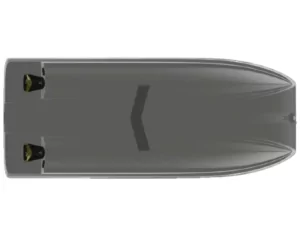Fitting a Seakeeper on a Catamaran: Is It Necessary?
Understanding Stabilisation Options and the Inherent Advantages of Power Catamarans
When discussing marine comfort, few topics come up more often than stabilisation—especially for those new to boating or transitioning from monohulls. One of the most well-known solutions is the Seakeeper gyro stabiliser, a system designed to reduce boat roll and improve comfort at sea. But when it comes to power catamarans—especially high-performance models like those from Makai—is a Seakeeper even necessary?
What Is a Seakeeper?
A Seakeeper is a gyroscopic stabiliser that reduces boat roll by up to 95%. It works by spinning a flywheel at high speeds in a vacuum-sealed enclosure. When the boat rolls, the gyroscope tilts and applies a counteracting torque to stabilise the vessel. It’s an impressive piece of engineering that offers a smoother ride and greater onboard comfort, especially when stationary or at slow speeds.
Other Forms of Marine Stabilisation
Beyond gyroscopic systems, there are several other methods used to stabilise boats:
- Fin Stabilizers: These are external fins mounted beneath the hull that pivot to counteract motion. They work best while the boat is underway.
- Intercept Trim Tabs: Though primarily used for trim and planing performance, some advanced systems can provide lateral stability.
- Ballast Systems: Adding weight or shifting ballast can help balance a vessel, though this is more common in commercial or larger displacement craft.
- Active Foils or T-Foils: More commonly found in racing or superyacht applications, these can significantly reduce pitch and roll by dynamically adjusting submerged control surfaces.

Each of these solutions carries a mix of advantages, costs, maintenance requirements, and trade-offs in terms of complexity and power consumption.
Do Catamarans Need Stabilisation?
Unlike monohulls, catamarans are inherently stable thanks to their wide beam and dual-hull design. This layout significantly reduces roll motion—the very type of movement that most stabilisers are designed to combat.
Power catamarans, in particular, benefit from:
- Greater beam-to-length ratios, offering natural lateral stability.
- Even weight distribution across two hulls, minimizing rocking.
- A more level ride through waves, reducing both pitch and roll compared to a monohull of similar length.
This means that the conditions that might prompt a Seakeeper installation on a monohull are often absent or drastically reduced on a power catamaran.
The Makai Advantage
At Makai Power Catamarans, our hulls are specifically engineered to offer a soft, stable ride at high speeds, even in open water. Our designs combine performance with comfort, eliminating the need for complex and costly stabilisation systems. Owners benefit from:
- Lower fuel consumption due to efficient hull shapes.
- Increased usable deck space without sacrificing ride quality.
- Simplicity and reliability, avoiding the added maintenance of mechanical stabilisation.
Installing a Seakeeper on a Makai is technically possible, but it’s rarely—if ever—necessary. In fact, most owners find that the natural poise and control of a Makai catamaran outperforms even the best-stabilised monohulls.
Conclusion
While the Seakeeper and similar systems are excellent tools for increasing comfort aboard monohulls and certain larger yachts, the inherent design of a power catamaran, especially one from Makai, offers all the benefits of stabilisation without the added cost, complexity, or weight. When your hull is this well-balanced, stability is built in.
